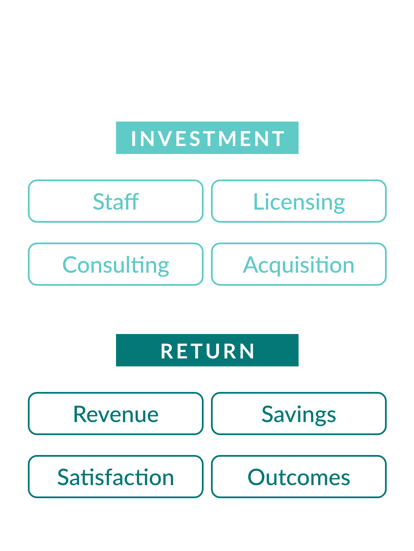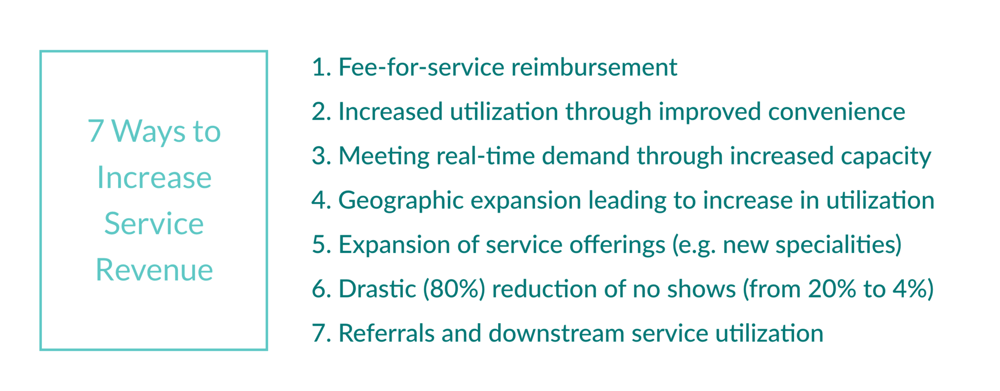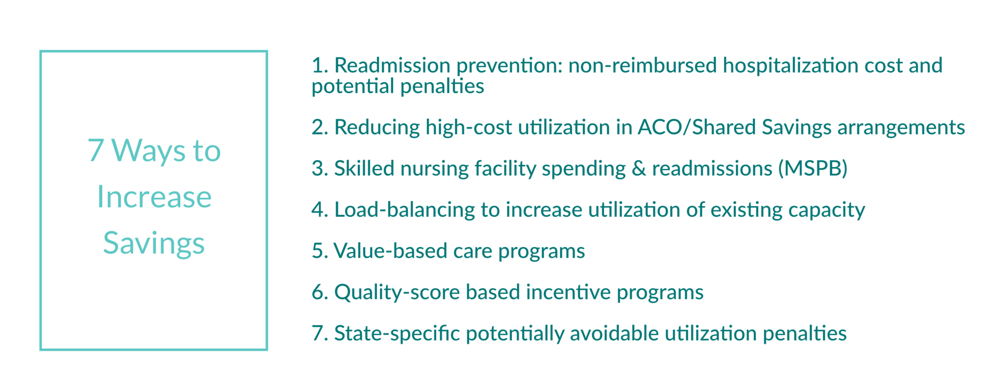Maximizing Your ROI
ROI, or return on investment, is a simplified calculation that, generally speaking, calculates the value of an investment: If for every $10 invested you generate $25 worth of return, your return on that $10 investment is $15 dollars, or 150
A positive ROI is obviously important to sustain the service, otherwise it needs to be subsidized. Across any given health systems, a number of health services are “money losers” that need to be subsidized by those services with a high return on investment.

Elements of Telehealth ROI
The ROI of telehealth programs can vary greatly based on the size, nature, clinical capacity and payment model of the organization as this Manatt Health Strategies report lays out. In addition to these nuances, less than half of healthcare organizations in survey conducted by Foley & Lardner law firm cited tracking their telehealth ROI.
When we work with clients, we aim to develop a program-level telehealth accounting system that looks at the cost and the benefits (“value generated”) of all telehealth services. The idea behind that approach is to ensure the overall sustainability of the telehealth program by ensuring that those services that may provide a negative ROI are offset by those that provide a positive ROI.
For example, some readmission remote patient monitoring (RPM) programs return $130 dollars for every $10 invested, an ROI of 13:1 or 1,300%! Other services, due to issues with collections on copays or lower reimbursement, may have a negative ROI of -20%, i.e., a loss of $2 on every $10 invested.
Qualitative and Quantitative Value
The value in an ROI calculation can be measured both quantitatively and qualitatively.
QUALITATIVE
Qualitative value measures intangible things such as patient or physician satisfaction or the net promoter score (NPS) that measures patient’s willingness to recommend, to promote the service to others. While they can be measured, they are qualitative in the sense that they cannot easily and reliably be converted into dollars.
QUANTITATIVE
The most obvious quantitative value measure is the reimbursement or cash pay for the rendered telehealth service. Other quantitative measures that we’ll discuss in more detail below, include other means of generating revenue as well as increasing savings or securing grants.
The Cost of Telehealth
To calculate the ROI, we first need to comprehensively account for all the costs associated with providing the service. This includes the salary of the clinicians as well as the clinical and administrative support staff; and ongoing technology licensing fees as well as the depreciation of one-time investments, such as hardware or software acquisition and installation cost.
A note on the licensing cost: these days most telehealth solutions are very reasonably priced and don’t offer much differentiation to boost the ROI of a telehealth service. Given the typical volume of telehealth visits per month — even if only practiced part time — the per-visit fees of the technology can be as low as $0.50.
The highest cost of any telehealth services is thus by far the cost of the clinicians, though the cost of support staff (especially in services whose workflows are not optimized or when highly cumbersome or non-intuitive technology is used) can also contribute significantly to this side of the ROI equation.
Telehealth Value with an Impact on the Bottom-Line
When looking at the quantifiable value of telehealth there are two areas of value that have an impact on the bottom line: increasing revenue and increasing savings. Aside from the obvious reimbursement, there are a number of other ways to increase revenue with a telehealth service.

On the other side, there are the number of ways to increase savings through telehealth:

Maximizing your Telehealth ROI
As illustrated by these two lists above, telehealth can be leveraged as a strategic tool in a number of ways to drive revenue or savings based on the circumstances and strategic priorities of the organization. With such methods and ultimately by diverting patients away from unnecessary more expensive in-person care appointments, recent studies have shown that telemedicine visits are able to generate cost savings estimated at $19 to $120 per patient visit.
Understanding how exactly to maximize your returns however seems to remain an area for improvement. The Advisory Board reports that only 21% of those providing telehealth are highly successful in achieving financial return for their virtual services. The good news is that it does not have to be so complicated. By adopting recommended best practices, an organization can create compliant, sustainable workflows that would meet requirements for coverage, coding, and documentation, while increasing reimbursement and overall program revenue.
As laid out in the cost section above, lowering technology-related expenses is usually not the most lucrative way to increase the ROI, unless of course you are subscribing to an expensive service that provides the clinicians, in addition to the technology. Here, the solution may be to bring the clinicians in house.
3 MOST POWERFUL TACTICS:
To maximize your Telehealth ROI consider the following:
- Roll up the ROI of all telehealth services at the telehealth program level to manage all virtual care offerings together to achieve synergies.
- Focus on building and growing those services with a high potential for a high ROI, rather than “making it up in volume” for telehealth services that are losing money each visit.
- Intentionally select new telehealth service offerings that can be designed for maximum ROI, thus using telehealth as a strategic tool, for example, to eliminate penalties, reduce no shows, etc.
How are you measuring the ROI of your telehealth service offerings? When launching a new service, do you set expectations for an ROI?

SUBSCRIBE FOR OUR LATEST CONTENT